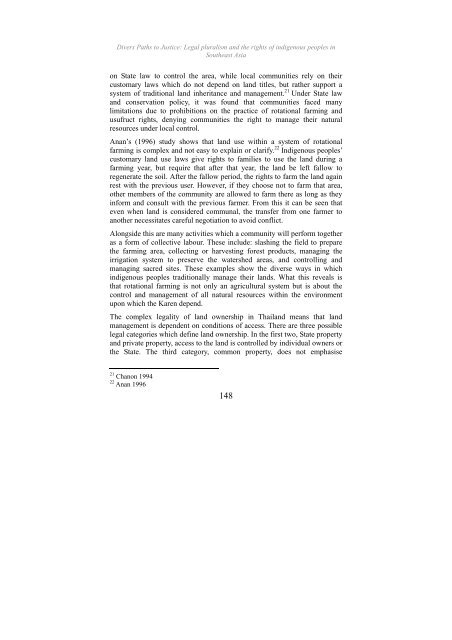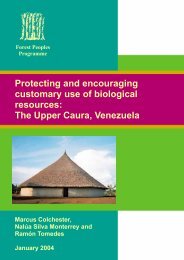Divers Paths to Justice - English - Forest Peoples Programme
Divers Paths to Justice - English - Forest Peoples Programme
Divers Paths to Justice - English - Forest Peoples Programme
Create successful ePaper yourself
Turn your PDF publications into a flip-book with our unique Google optimized e-Paper software.
<strong>Divers</strong> <strong>Paths</strong> <strong>to</strong> <strong>Justice</strong>: Legal pluralism and the rights of indigenous peoples inSoutheast Asiaon State law <strong>to</strong> control the area, while local communities rely on theircus<strong>to</strong>mary laws which do not depend on land titles, but rather support asystem of traditional land inheritance and management. 21 Under State lawand conservation policy, it was found that communities faced manylimitations due <strong>to</strong> prohibitions on the practice of rotational farming andusufruct rights, denying communities the right <strong>to</strong> manage their naturalresources under local control.Anan’s (1996) study shows that land use within a system of rotationalfarming is complex and not easy <strong>to</strong> explain or clarify. 22 Indigenous peoples’cus<strong>to</strong>mary land use laws give rights <strong>to</strong> families <strong>to</strong> use the land during afarming year, but require that after that year, the land be left fallow <strong>to</strong>regenerate the soil. After the fallow period, the rights <strong>to</strong> farm the land againrest with the previous user. However, if they choose not <strong>to</strong> farm that area,other members of the community are allowed <strong>to</strong> farm there as long as theyinform and consult with the previous farmer. From this it can be seen thateven when land is considered communal, the transfer from one farmer <strong>to</strong>another necessitates careful negotiation <strong>to</strong> avoid conflict.Alongside this are many activities which a community will perform <strong>to</strong>getheras a form of collective labour. These include: slashing the field <strong>to</strong> preparethe farming area, collecting or harvesting forest products, managing theirrigation system <strong>to</strong> preserve the watershed areas, and controlling andmanaging sacred sites. These examples show the diverse ways in whichindigenous peoples traditionally manage their lands. What this reveals isthat rotational farming is not only an agricultural system but is about thecontrol and management of all natural resources within the environmentupon which the Karen depend.The complex legality of land ownership in Thailand means that landmanagement is dependent on conditions of access. There are three possiblelegal categories which define land ownership. In the first two, State propertyand private property, access <strong>to</strong> the land is controlled by individual owners orthe State. The third category, common property, does not emphasise21 Chanon 199422 Anan 1996148
















